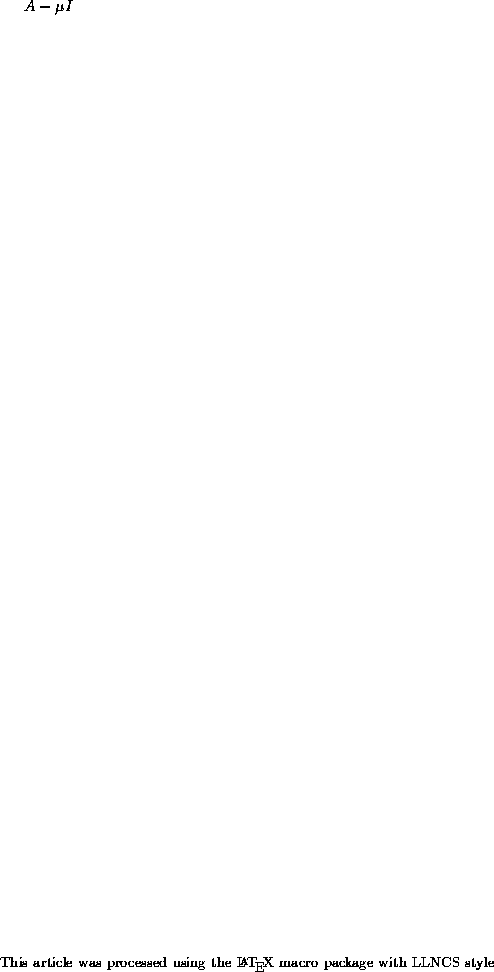Basic Iterative Algorithms



Next: Cost Issues
Up: Templates for Solution
Previous: Available Operations
The following basic algorithms for sparse eigenproblems will be included.
- Simultaneous iteration methods
- Arnoldi methods
- Lanczos methods
- Davidson methods
- Refinement methods
- Trace minimization (self-adjoint case only)
This list is not exhaustive, and we are actively looking for other
algorithms. Also, some common methods may classified in several ways.
For example, simultaneous iteration and block Arnoldi with an immediate
restart are identical. These categories are not meant to be mutually
exclusive, but to be helpful to the user. We will include some older
but commonly used methods, just to be able to advise the user to use
more powerful alternatives, and for experimental purposes.
Arnoldi and Lanczos methods are Krylov subspaces based techniques.
These methods may converge very fast in combination with
shifted-and-inverted operators, which means that  has
to be used in matrix vector products in each iteration step. If only
approximations for
has
to be used in matrix vector products in each iteration step. If only
approximations for  are available then Davidson's
method can be used as an acceleration technique for the inexact
shift-and-invert operations. Approximations for
are available then Davidson's
method can be used as an acceleration technique for the inexact
shift-and-invert operations. Approximations for  can be computed from a preconditioner for
can be computed from a preconditioner for  or by a few steps
of a (preconditioned) iterative method [35].
or by a few steps
of a (preconditioned) iterative method [35].
Trace minimization is suitable for self-adjoint
problems, and uses optimization techniques like conjugate
gradients to find the  smallest eigenvalues.
smallest eigenvalues.
There is unfortunately no simple way to identify the best algorithm
and choice of options to the user. The more the user discovers about
the problem (such as approximate eigenvalues), the better a choice
can be made. In the common situation where the user is solving a
sequence of similar problems, this is quite important.
There is also unfortunately no inexpensive way to provide a
guarantee that all eigenvalues in a region have been found,
when the problem is not self-adjoint.
For Hermitian eigenvalue problems by factoring certain translations of  by the identity, it is possible to guarantee that all eigenvalues in a
region have been found. In the non-Hermitian case, this same task is
accomplished by a vastly more expensive technique called a Nyquist plot
(i.e. compute the winding number).
However, depending on the
problem, there are methods to help increase one's confidence
that all eigenvalues have been found.
by the identity, it is possible to guarantee that all eigenvalues in a
region have been found. In the non-Hermitian case, this same task is
accomplished by a vastly more expensive technique called a Nyquist plot
(i.e. compute the winding number).
However, depending on the
problem, there are methods to help increase one's confidence
that all eigenvalues have been found.



Next: Cost Issues
Up: Templates for Solution
Previous: Available Operations
Jack Dongarra
Wed Jun 21 02:35:11 EDT 1995
 has
to be used in matrix vector products in each iteration step. If only
approximations for
has
to be used in matrix vector products in each iteration step. If only
approximations for  are available then Davidson's
method can be used as an acceleration technique for the inexact
shift-and-invert operations. Approximations for
are available then Davidson's
method can be used as an acceleration technique for the inexact
shift-and-invert operations. Approximations for  can be computed from a preconditioner for
can be computed from a preconditioner for  or by a few steps
of a (preconditioned) iterative method [35].
or by a few steps
of a (preconditioned) iterative method [35].
 smallest eigenvalues.
smallest eigenvalues.
 by the identity, it is possible to guarantee that all eigenvalues in a
region have been found. In the non-Hermitian case, this same task is
accomplished by a vastly more expensive technique called a Nyquist plot
(i.e. compute the winding number).
However, depending on the
problem, there are methods to help increase one's confidence
that all eigenvalues have been found.
by the identity, it is possible to guarantee that all eigenvalues in a
region have been found. In the non-Hermitian case, this same task is
accomplished by a vastly more expensive technique called a Nyquist plot
(i.e. compute the winding number).
However, depending on the
problem, there are methods to help increase one's confidence
that all eigenvalues have been found.